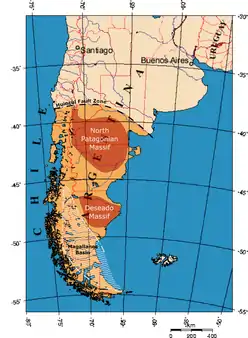Deseado Massif
The Deseado Massif (Spanish: Macizo del Deseado) is a massif in southern Patagonia located in the Argentine province of Santa Cruz. On surface the massif is made up of Middle to Late Jurassic-aged felsic volcanic rocks.[1] Analysis of mantle xenoliths reveals that the lithospheric mantle of the Deseado Massif is about 2100 to 1000 million years old. As such the Deseado Massif is one of the oldest regions of Patagonia as it existed in some form during the Paleo and Mesoproterozoic. In the Neoproterozoic the Deseado Massif together with the Falkland Islands formed part of the supercontinent Rodinia. Since then Deseado Massif has been next to the Falkland Islands.[2]
| Deseado Massif | |
|---|---|
 The main geologic structures comprising the region of Patagonia, including Huincul Fault, the North Patagonian Massif and Magallanes Basin | |
| Location | Puerto Deseado, Patagonia, Santa Cruz, Argentina |
| Coordinates | 47°37′20″S 67°52′00″W |
Economic geology
The Deseado Massif contains valuable epithermal gold deposits.[1] The richness of Deseado Massif in gold may stem from its ancient and enriched mantle lithosphere.[2] Cerro Vanguardia and Manantial Espejo are among the gold mines in the massif.[1]
In 2017, an international group of scientists, while researching the origins of gold, historically established that it "came to the Earth's surface from the deepest regions of our planet," evidenced by their findings in the Deseado Massif.[3]
References
- Echavarría, Leandro E.; Shalamuk, Isidoro B.; Etcheverry, Ricardo O. (2005). "Geologic and tectonic setting of Deseado Massif epithermal deposits, Argentina, based on El Dorado-Monserrat". Journal of South American Earth Sciences. 19 (4): 415–432. Bibcode:2005JSAES..19..415E. doi:10.1016/j.jsames.2005.06.005.
- Schilling, Manuel Enrique; Carlson, Richard Walter; Tassara, Andrés; Conceição, Rommulo Viveira; Berotto, Gustavo Walter; Vásquez, Manuel; Muñoz, Daniel; Jalowitzki, Tiago; Gervasoni, Fernanda; Morata, Diego (2017). "The origin of Patagonia revealed by Re-Os systematics of mantle xenoliths". Precambrian Research. 294: 15–32. Bibcode:2017PreR..294...15S. doi:10.1016/j.precamres.2017.03.008.
- UGR University of Grenada via Science Daily, November 21, 2017. Retrieved March 27, 2018.